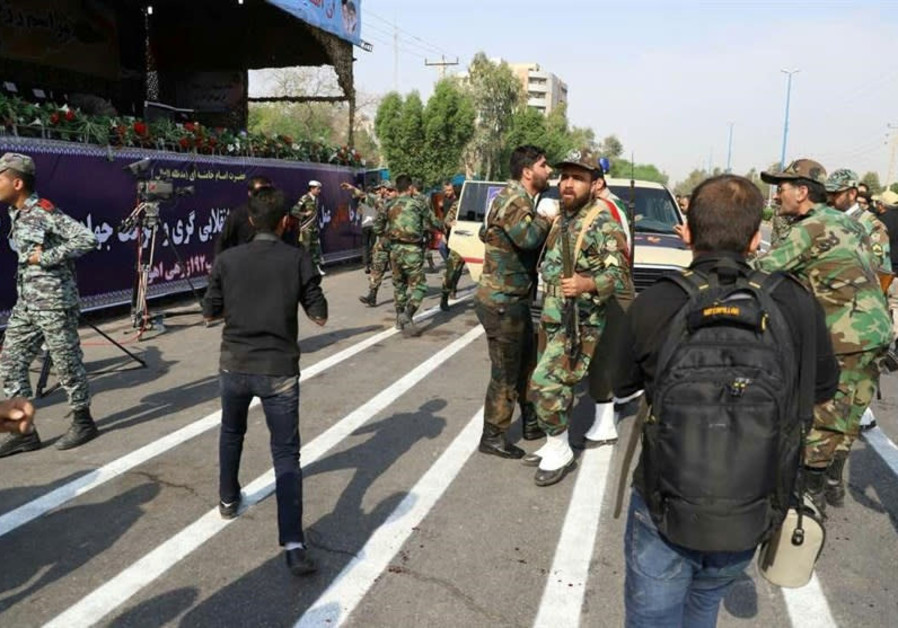Iran regime fears foreign support for minority groups after attack

A general view of the attack during the military parade in Ahvaz, Iran, 2018. (photo credit: REUTERS/TASNIM NEWS AGENCY)
The Iranian regime was quick to respond to Saturday’s terrorist attack in Ahvaz, the capital of Khuzestan Province in its southwest, by pointing fingers at Washington. This is the easy playbook for Tehran: Blame someone else.
Even before the number of casualties was known – at least 25 killed and 60 injured – Iranian Foreign Minister Javad Zarif had claimed that the terrorists who struck the military parade in the city of 1.3 million were “recruited, trained, armed and paid” by foreign countries.
Terrorists recruited, trained, armed & paid by a foreign regime have attacked Ahvaz. Children and journos among casualties. Iran holds regional terror sponsors and their US masters accountable for such attacks. Iran will respond swiftly and decisively in defense of Iranian lives. pic.twitter.com/WG1J1wgVD9
— Javad Zarif (@JZarif) September 22, 2018
The Iranian regime has long sought to stoke conspiracy theories and portray itself as a victim of foreign terrorism, often scapegoating the US for all the region’s problems. Last year Supreme Leader Ayatollah Ali Khamenei accused the US of “creating ISIS” and said the US claim to be fighting ISIS was “a lie.” After the terrorist attack in Ahvaz he said the same thing, pointing fingers at the US while members of his regime pointed fingers as Saudi Arabia.
How could Zarif and the ayatollah have known that the US and Saudi Arabia were behind the attack only hours after it took place, when the regime didn’t even know the body count and had only claimed to have killed two out of the four perpetrators?
The young men’s bodies who the regime said were responsible had no identification. Yet Iranian state media reported that “takfiri gunmen” were held responsible. Official and state-sponsored media outlets such as Fars and Press TV said the attackers were “US puppets.”
The two remaining perpetrators were eventually killed by the security forces, which has vowed a crackdown, but it has not produced any evidence linking them to the US or foreign states.
Iran’s desire to turn the attack into an international incident reveals its fear over growing protests and attacks on the Islamic Revolutionary Guard Corps across Iran.
In the Kurdish region several groups have targeted the IRGC, which they see as the spearhead of the regime’s oppression. In response, the IRGC launched seven Fateh-110 ballistic missiles at Kurdish opposition groups in Iraq on September 10. The US condemned the missile attack. In addition, the US condemned Iran for an attempted attack on its consulate in Basra, saying Tehran would be held accountable for actions of Iranian-backed militias in Iraq.
Tehran’s attempt to paint the Ahvaz attack as a US operation is therefore its way of saying that the US is attempting a proxy war within Iran, rather than Iran carrying out a proxy war in Iraq. In short, the regime is saying: If you accuse us of attacks in Iraq and elsewhere, we will hold you accountable for what happens in Iran.
The various Ahvaz groups that oppose the Iranian regime are similar to Kurdish groups that also oppose the regime. The Ahvaz region is home to a large Arab minority that says its rights are deprived under the regime. During the Iran-Iraq war this was a restive region and scene of fighting. It is for this reason that the attack on the IRGC parade was symbolic. The parade was meant to commemorate the start of the Iran-Iraq war. The terrorists struck at the IRGC during the parade.
This is the largest attack of this kind in recent memory in Iran. Last year ISIS targeted Tehran and killed more than a dozen civilians. Saturday’s attack was larger and targeted a regime military symbol. That at least one of the gunmen came dressed in fatigues of the marchers will lead to fear within the IRGC ranks of more copycat attacks.
Iran will want to leverage this for propaganda reasons, to encourage the supporters of the regime to mourn the “martyrs” in the south, and to label minority groups as “terrorists” and “takfiri” groups aligned with Saudi Arabia or the US. This is a way to delegitimize the minority groups who have protested the regime for years. It will also serve as a way to paint other peaceful protests are part of a foreign “conspiracy.” As the regime feels isolated from sanctions it wants to see a US hand behind all its problems.
Questions will be asked about why this attack was so deadly. How did men carrying automatic weapons get into the parade? Who were they? Did they receive training and backing? Where did they get their uniforms? Why didn’t the soldiers present shoot back? Video shows the hundreds of soldiers running. They didn’t appear to confront the attack, which likely led to a higher death toll. The attack will also lead to questions about whether the Ahvaz issue will now become a new insurgency, or if this was a unique and deadly incident.
Join Jerusalem Post Premium Plus now for just $5 and upgrade your experience with an ads-free website and exclusive content. Click here>>






Comments are closed.